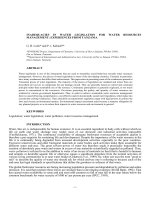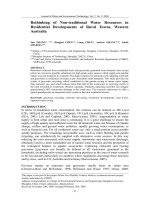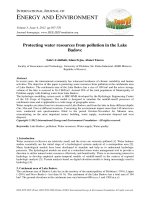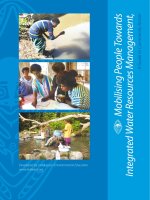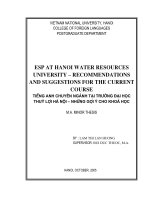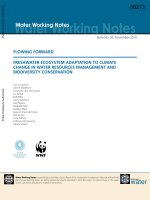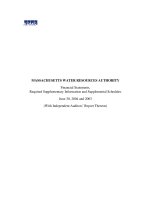Environmental Science: Water resources
Bạn đang xem bản rút gọn của tài liệu. Xem và tải ngay bản đầy đủ của tài liệu tại đây (806.41 KB, 21 trang )
We can’t exist without water
Formula: Water is a chemical compound consisting of two hydrogen atoms
and one oxygen. The name water typically refers to the liquid state of the
compound. The solid phase is known as ice and gas phase is called steam.
The importance of water:
Water supply:
Water is the most common substance on Earth. Water makes up about 50% 90% of the weight of things. Regardless of language or culture, all humans
share this basic need that is essential for survival.
Water is a key component in determining the quality of our lives
We drink water, cook with it, bathe in it, sprinkle our lawns with it, fill our
backyard swimming pools with it – even create theme parks base on it.
All living things need water
Water is over 70% of body
Involved in the metabolism: oxygen, minerals,…
Involved in most of the systems in the organism’s body
Without water, there can be no life. In fact, every living thing consists mostly
of water. Your body is about two-thirds water. A chicken is about threefourths water and a pineapple is about four-fifths water. Most scientists
believe that life itself began in water, in the salty water of the sea.
Water helps keep the earth’s climate from getting too hot or too cold. Land
adsorbs and releases heat from the sun quickly. But the oceans adsorbs and
release the sun’s heat slowly. So breezes from the oceans bring warmth to
the land in winter and coolness in summer.
Water is vital as well as the start of human civilization
From the past, people living in concentrated areas near rivers and the sea
because there is abundant food sources, convenient for living and
production. Typical is the civilization of the Nile River, Yellow River, India
river..., the Mediterranean, the Gulf Coastal…
They have worshiped rain gods and prayed for rain. Often, when rains have
failed to come, crops have withered and starvation has spread across a land.
Sometimes the rains have fallen too heavily and too suddenly. Then rivers
have overflowed their banks, drowning large numbers of people and causing
enormous destruction of property.
Today, more than ever, water is both slave and master to people. We use
water in our homes for cleaning, cooking, bathing, and carrying away
wastes. We use water to irrigate dry farmlands so we can grow more food.
Our factories use more water than any other material. We use the water in
rushing rivers and thundering waterfalls to product electricity.
Water in agriculture
It is estimated that 70% of world-wide
water use is for irrigation. In some
areas of the world, irrigation is
necessary to grow any crop at all, in
other areas it permits more profitable
crops to be grown or enhances crop
yield. Various irrigation methods
involve different trade-offs between crop yield, water consumption and
capital
cost
of
equipment
and
structures.
Most of the plants that people raise need great quantities of water. For
example, it takes 115 gallons (435 liters) of water to grow enough wheat to
bake a loaf of bread. People raise most of their crops in areas that have
plenty of rain. But to raise enough food for their needs, people must also
irrigate dry areas. The rainfall that crops use to grow is not considered a
water use, because the water does not come from a country's supply.
Irrigation, on the other hand, is a water use because the water is drawn from
a
nation's
rivers,
lakes,
or
wells.
The water a nation uses for irrigation is important to its water supply
because none of the water remains for reuse.
Water for industry
It is estimated that 15% of world-wide water use is industrial. Major
industrial users include power plants, which use water for cooling or as a
power source (i.e. hydroelectric plants), ore and oil refineries, which use
water in chemical processes, and manufacturing plants, which use water as
a solvent.
The industry in turn uses water in many ways. It uses water for cleaning
fruits and vegetables before canning and freezing them. It uses water as a
raw material in soft drinks, canned foods, and many other products. It uses
water to air-condition and clean factories. But most of the water used by
industry is for cooling. For example, water cools the steam used in producing
electric power from fuel. It cools the hot gases produced in refining oil, and
the
hot
steel
made
by
steel
mills.
Although industry uses a lot of water, only 6 per cent
of it is consumed. Most of the water used for cooling
is piped back to the rivers or lakes from which it is
taken. The water consumed by industry is the water
added to soft drinks and other products, and the
small amount of water that turns to vapor in the
cooling processes.
Water for hydroelectricity
Water power, or hydropower, furnishes about 7
percent of the world's commercial energy. Where water flows from a high
place to a lower one, the gravitational energy of the falling water can be
captured and used to produce other forms of energy. Most waterpower is
used to generate electric power. Waterpower supplies energy without
pollution and without using up the water in the process. But costly dams and
other
structures
are
required
to
harness
waterpower.
People also use water to produce electric power to light homes and to run
factories. Electric power stations burn coal or other fuel to turn water into
steam. The steam supplies the energy to run machines that produce
electricity. Hydroelectric power stations use the energy of falling water from
waterfalls and dams to produce electricity.
Water for transport
After people learned to build crude small boats, they began using rivers and
lakes to carry themselves and their goods. Later, they built larger boats and
sailed the ocean in search of new lands and new trade routes. Today, people
still depend on water transportation to carry such heavy and bulky products
as machinery, coal, grain, and oil.
Water for tourism
Marine, lakes, flooded forests… tourism state contribution to the
development of the tourism industry as well as each country's economy.
People travel not only to entertain but also to explore life in the ocean,
aquatic organisms and the culture of the people
who live there
People build most of their recreation areas along
lakes, rivers, and seas. They enjoy water sports,
such as swimming, fishing, and sailing. Many
people also enjoy the beauty of a quiet lake, a
thundering waterfall, or roaring surf.
Water in our daily live
Every plant, animal, and human being needs water to stay alive. This is
because all the life processes, from taking in food to getting rid of wastes,
require water. But people depend on water for more than just to stay alive.
We also need it for our way of life. We need water in our homes, to brush our
teeth,
cook
food,
and
wash
dishes.
Every living thing must keep its water supply near normal, or it will die.
Human beings can live without food for more than two months, but they can
live without water for only about a week. If the body loses more than 20 per
cent of its normal water content, a person will die painfully. Human beings
must take in about 2.4 liters of water a day. This intake can be in the form of
beverages we drink, or water in food.
Water appears all over the world
The arrangement of water
There are 5 compartments to arrange water in the world
Oceans
Glaciers, ice, snow
1.
•
•
•
•
•
Under ground
Rivers and stream
Lakes, ponds, and wetlands
The graph below show the water compartments and the percentage of them
in the earth:
The water reserves in the compartments
Oceans
There are 5 major oceans on the globe , namely, Indian ocean, Atlentic
ocean, Pacific ocean, Arctic ocean. In addition, there are also some seas such
that, east china sea, north sea, open sea…
By nature, water in the seas and oceans are salt,not appropriate to human
use.
There are some information about sea water. The average salt
concentration is 3.5%,that mean there are 35 gam salt on 1000 ml sea
water. Phan Lan bay is where have lowest salt concentration, the highest of
open sea is Red Sea while that of close sea is Death Sea. The quantity of salt
on sea water depend on some factors, namely, mix of salt and fresh water,
movement of water.
The amount of salty cloruanatri in blood of human is adjusted and
maintained at 9g/l.If we drink sea water, the salt concentration in blood will
raise in moment, as far as, the natri concentration in blood will increase too
much, then our body will be poisoned, seized with apoplexy and lead to
death.
Groundwater
2.
Water run off over the surface percolates through the soil and into
fractures and spaces of permeable rocks in a process called infiltration
It is partitioned to 3 zones which contain water in it
Firstly, zone of aeration where hold both air and water, is upper soil
layers. it is useful for plant growth.
Secondly, zone of saturation is slower layers where are filled with water.
The water table in the top of this zone is not flat but undulates according
surface topography and subsurface structure. It can be stationary, rising or
falling according precipitation and infiltration rates.
Thirdly, recharge aquifer zone where consist of rock and soil absorb
and hold water. Water will be infiltrated into an aquifer occur are called
recharge zones with a ration is very slow.
River and Streams
The water in the river and streams are fresh waters
It is important to human and most other organisms
The volume of water in lakes and streams are constantly replenished by
precipitation, meltwater from snow and ice or seepage from groundwater.
In the world, there are 16 largest river carry nearly a half of all surface
runoff on earth, namely, amazon across brazil and peru, Orinoco across
Venezuela and Colombia, Congo flow into Congo…etc…
Lakes, ponds and wetlands
Lakes and ponds contain fresh water, but wetlands consist of salt water.
Although, it is only minor component of total world water supply, but their
water may be accessible than groundwater and important in many ways for
human and another organism.
Wetlands play a vital and often unappreciated role in the hydrologic cycle.
Their lush plant growth stabilizes soil and hold back surface runoff, allowing
time for infiltration into aquifer producing even, year-long stream flow.
Atmosphere
It is smallest of the major water compartments, contain less than 0.001
percent of the total water supply.
The movement of water through the atmosphere provide the mechanism for
distributing fresh water over the landmasses and replenishing terrestrial
reserves.
Glaciers, ice, and snow
Glacier are rivers of ice flowing downhill very slowly. They now occur only at
high altitudes or high latitudes. The largest amount of ice remnant is in
Antarctica and made up 85% of all ice in the world.
15% of all ice in the world on Greenland and mountain snow pack.
Reserves of water can be shown from the kind of water.
Based on quantity of salt on water , science divide up 4 type of water. The
table below will show to you details.
Water salinity based on dissolved salts in parts per thousand
3.
Fresh
water
< o.5
•
•
•
Brackish
water
0.5-30
Salt water
Brine
30-50
>50
Fresh water
Freshwater is defined as having a low salt concentration — usually less
than 1%. Thực vật và động vật ở các vùng nước ngọt được điều chỉnh hàm
lượng muối thấp và không thể để tồn tại trong khu vực có nồng độ muối cao
(tức là đại dương). Plants and animals in freshwater regions are adjusted to
the low salt content and would not be able to survive in areas of high salt
concentration (ice, ocean). Có nhiều loại khác nhau của các vùng nước ngọt:
There are different types of freshwater regions:
Ponds and lakes
Streams and rivers
Wetlands
The source of almost all fresh water is precipitation from the atmosphere , in
the form of mist , rain and snow . Nước ngọt thuộc như mưa, sương mù và
tuyết tan các chất từ và vật chất từ biển và đất trên đó các đám mây mang
mưa có đi du lịch. Fresh water falling as mist, rain or snow contains
materials dissolved from the atmosphere and material from the sea and land
over which the rain bearing clouds have traveled.
Out of all the water on Earth , only 2.75 percent is fresh water, including 2.05
percent frozen in glaciers, 0.68 percent as groundwater and 0.011 percent of
it as surface water in lakes and rivers. Freshwater lakes, most notably Lake
Baikal in Russia and the Great Lakes in North America, contain seven-
eighths of this fresh surface water. Đầm lầy có hầu hết các cân bằng với chỉ
một lượng nhỏ ở các sông, đặc biệt là các [. ] Không khí chứa nước 0,04%.
Trong khu vực không có nước ngọt trên mặt đất, nước ngọt có nguồn gốc từ
mưa có thể, vì mật độ thấp của nó, che phủ mặt đất nước mặn trong ống
kính hoặc lớp. Swamps have most of the balance with only a small amount in
rivers, most notably the Amazon River. The atmosphere contains 0.04%
water. In areas with no fresh water on the ground surface, fresh water
derived from precipitation may, because of its lower density, overlie saline
ground water in lenses or layers. Phần lớn nước ngọt của thế giới đang đóng
băng trong . Most of the world's fresh water is frozen in ice sheets
Fresh water can be used as a resource.
Thay đổi cảnh quan cho việc sử dụng nông nghiệp có ảnh hưởng lớn đến
dòng chảy của nước ngọt. Changing landscape for the use of agriculture has
a great effect on the flow of fresh water. Thay đổi trong phong cảnh của việc
loại bỏ các cây và thay đổi dòng chảy của nước trong lành trong môi trường
địa phương và cũng ảnh hưởng đến chu kỳ của nước ngọt. Changes in
landscape by the removal of trees and soils changes the flow of fresh water in
the local environment and also affects the cycle of fresh water. Kết quả là
nhiều nước ngọt được lưu trữ trong đất có lợi ích nông nghiệp. As a result
more fresh water is stored in the soil which benefits agriculture. Tuy nhiên,
từ nông nghiệp là những hoạt động mà tiêu thụ nước sạch nhất, điều này
có thể đặt một căng thẳng nghiêm trọng về tài nguyên nước ngọt địa
phương dẫn đến việc phá hủy các hệ sinh thái địa phương. However, since
agriculture is the human activity that consumes the most fresh water, this
can put a severe strain on local freshwater resources resulting in the
destruction of local ecosystems. Tại Úc, quá trừu tượng của nước ngọt cho
thâm canh hoạt động đã gây ra 33% diện tích đất có nguy cơ của nhiễm
mặn. [12] In Australia, over-abstraction of fresh water for intensive irrigation
activities has caused 33% of the land area to be at risk of salivation.
Limiting resource
Nước ngọt là nguồn tài nguyên thiên nhiên tái tạo và thay đổi, nhưng hạn
chế. Fresh water is a renewable and changeable, but limited natural
resource. nước tươi chỉ có thể được gia hạn thông qua quá trình của chu kỳ
nước, nơi nước từ biển, hồ, sông, và đập bay hơi, hình thức các đám mây, và
trở về nguồn nước như mưa. Fresh water can only be renewed through the
process of the water cycle, where water from seas, lakes, rivers, and dams
evaporates, forms clouds, and returns to water sources as precipitation. Tuy
nhiên, nếu có nhiều nước ngọt được tiêu thụ thông qua các hoạt động của
con người hơn là phục hồi một cách tự nhiên, kết quả là số lượng nước sạch
có sẵn trong các hồ, sông, đập nước và các vùng nước ngầm bị giảm mà có
thể gây ra thiệt hại nghiêm trọng đến môi trường xung quanh. However, if
more fresh water is consumed through human activities than is restored by
nature, the result is that the quantity of fresh water available in lakes, rivers,
dams and underground waters is reduced which can cause serious damage
to the surrounding environment.
Ao, hồ
Brackish:
By definition, Brackish water is water that has more salinity than fresh
water, but not as much as seawater. It may result from mixing of seawater
with fresh water, as in estuaries, or it may occur in brackish fossil aquifers.
Technically, brackish water contains between 0.5 and 30 grams of salt per
liter—more often expressed as 0.5 to 30 parts per thousand (ppt or
Many species of animal can live by brackish water habitat. There are 4
brackish water habitat in earth, Estuaries, Mangroves, Brackish seas and
lakes and Brackish marsh
Brackish water condition commonly occur when fresh water meet seawater.
In fact, the most extensive brackish water habitats worldwide are estuaries,
where a river meets the sea. River estuaries form important staging points
during the migration of anatropous and catadromus fish species, such as
salmon and eels , giving them time to form social groups and to adjust to the
changes in salinity.By far, estuaries also commonly use as fishing ground,
and as place for fishing farming or ranching.
The Mangrove not only are necessary for life of fish, crocodile, proboscis
monkey but also very important buffer zones between land and sea, and are
a natural defense against hurricane and tsunami damage in particular.
Some rivers and lakes in earth are brackish. Baltic sea, Caspian sea and
Black sea are famous brackish Seas.
A brackish marsh may occur where a freshwater flow enters a salt marsh.
Salt water or Seawater
Seawater is water from a sea or ocean . Tính trung bình, nước biển trong
thế giới của các đại dương có khoảng 3,5% (35 g / L, hay 599 ). On average,
seawater in the world's oceans has a salinity of about 3.5% (35 g/L, or 599
mmHg). The average density of seawater at the ocean surface is 1.025 g/ ml.
Nước biển là so với cả và nước tinh khiết (mật độ 1,0 g / ml @ 4 ° C (39 °
F)) bởi vì các muối hòa tan thêm hàng loạt mà không có đóng góp đáng kể
vào âm lượng. Seawater is denser than both fresh water and pure water
(density 1.0 g/ml at 4 °C (39 °F)) because the dissolved salts add mass
without contributing significantly to the volume. Các của nước biển giảm
khi tăng nồng độ muối. Trường hợp xảy ra với dòng chảy trộn nước ngọt từ
cửa sông hay gần các sông băng tan chảy, nước biển có thể được đáng kể ít
mặn.Các biển mặn nhất là , nơi có tỷ lệ cao của , ít và dòng sông, và kết quả
bị hạn chế lưu thông trong nước mặn khác thường.Độ mặn trong cơ thể cô
lập của các nước (ví dụ, các ) có thể được vẫn lớn hơn đáng kể.
Các của bề mặt nước biển dao động từ khoảng 1.020 đến 1.029 kg • m -3, tùy
thuộc vào nhiệt độ và độ mặn.
1.
Saline water is a general term for water that contains a significant
concentration of dissolved salts ( NaCl). tập trung thường được diễn tả
trong của muối. The concentration is usually expressed in parts per million
(ppm) of salt. People should be careful with using saline water. Accidentally
consuming small quantities of clean seawater is not harmful, especially if the
seawater is consumed along with a larger quantity of fresh water.
Tuy nhiên, uống nước biển để duy trì hydrat hóa là phản tác dụng, nước lên
phải được bài tiết để loại bỏ muối (thông qua hơn so với lượng nước mà là
thu được từ uống nước biển tự.)
The chemical composition of water.
By natural, the water contain some ion or nutrient what benefit to
heath of people.
elements
Oxygen
Percentage of water volume
85,84%
Chlorine
1,94%
Magnesium
0,1292%
Calcium
0,04%
Bromine
0.0026%
Hydrogen
10,82%
Sodium
1,08%
Sulfur
0.091%
The movement of water
Water cycle
The water cycle describes the existence and movement of water on, in,
and above the Earth. Earth's water is always in movement and is always
changing states, from liquid to vapor to ice and back again. The water cycle
has been working for billions of years and all life on Earth depends on it
continuing to work; the Earth would be a pretty stale place to live without it.
Where does all the Earth’s water come from? Primordial Earth was an
incandescent globe made of magma, but all magmas contain water. Water
set free by magma began to cool down the Earth’s atmosphere, until it could
stay on the surface as a liquid. Volcanic activity kept and still keeps
introducing water in the atmosphere, thus increasing the surface- and
ground-water volume of the Earth.
The water cycle has no starting point.
Evaporation and evapotranspiration The sun, which drives the water
cycle, heats water in the oceans. Some of it evaporates as vapor into the air.
Ice and snow can sublimate directly into water vapor. Rising air currents
take the vapor up into the atmosphere, along with water from
evapotranspiration, which is water transpired from plants and evaporated
from the soil.
Condensation The vapor rises into the air where cooler temperatures
cause it to condense into clouds. Air currents move clouds around the globe;
cloud particles collide, grow, and fall out of the sky as precipitation.
Precipitation Some precipitation falls as snow and can accumulate as ice
caps and glaciers, which can store frozen water for thousands of years.
Snowpack’s in warmer climates often thaw and melt when spring arrives,
and the melted water flows overland as snowmelt.
Runoff Most precipitation falls back into the oceans or onto land, where,
due to gravity, the precipitation flows over the ground as surface runoff. A
portion of runoff enters rivers in valleys in the landscape, with stream flow
moving water towards the oceans. Runoff, and ground-water seepage,
accumulate and are stored as freshwater in lakes. Not all runoff flows into
rivers, though.
Much of it soaks into the ground as infiltration. Some water infiltrates deep
into the ground and replenishes aquifers (saturated subsurface rock), which
store huge amounts of freshwater for long periods of time. Some infiltration
stays close to the land surface and can seep back into surface-water bodies
(and the ocean) as ground-water discharge, and some ground water finds
openings in the land surface and emerges as freshwater springs.
Over time, though, all of this water keeps moving, some to reenter the ocean
Tide
Tides are the rise and fall of sea levels
•
•
•
•
•
Uses to
Produce energy
Produce salt or Fish aquatic organisms
Serve military: example Bach Dang battle
Serve transportation
Types of Tide
Tides are most commonly semidiurnal (two high waters and two low waters
each day), or diurnal (one tidal cycle per day). The two high waters on a
given day are typically not the same height (the daily inequality); these are
the higher high water and the lower high water in tide tables. Similarly, the
two low waters each day are the higher low water and the lower low water.
The daily inequality is not consistent and is generally small when the Moon
is over the equator.
•
Reasons
•
The positions of Sun and Moon relative to Earth
•
The rotation of Earth
•
Altitude of Moon above Earth’s equator
Principal lunar semidiurnal constituent
In most locations, the largest constituent is the "principal lunar
semidiurnal", also known as the M2 (or M2) tidal constituent. Its period is
about 12 hours and 25.2 minutes, exactly half a tidal lunar day, which is the
average time separating one lunar zenith from the next, and thus is the time
required for the Earth to rotate once relative to the Moon.
Because the gravitational field created by the Moon weakens with distance
from the moon, it exerts a slightly harder tidal force on the side of the Earth
facing the Moon than on the opposite side. As the Earth rotates, the
magnitude and direction of the tidal force at any particular point on the
Earth's surface change constantly; although the ocean never reaches
equilibrium the changing tidal force nonetheless causes rhythmic changes in
sea surface height.
When there are two high tides each day with different heights (and two low
tides also of different heights), the pattern is called a mixed semidiurnal tide.
Ocean current
Ocean currents are moving directly, continuously and quiet stable in the
oceans
Warm ocean currents are derived from the equator or high latitude and
flowing toward the poles of the planet. Here, low temperature of ice cools
water to form a cold ocean current flowing toward the equator. Ocean
currents in the two hemispheres are opposite each other across the equator.
Surface currents make up about 10% of all the water in the ocean. Surface
currents are generally restricted to the upper 400 m (1,300 ft.) of the ocean.
The movement of deep water in the ocean basins is by density driven forces
and gravity. The density difference is a function of different temperatures
and salinity. Deep waters sink into the deep ocean basins at high latitudes
where the temperatures are cold enough to cause the density to increase.
Ocean currents are measured in Sverdrup (Sv), where 1Sv is equivalent to a
volume flow rate of 1,000,000 m3 (35,000,000 cu ft) per second
•
Characters:
1.
Affect in the climate of the continent, especially in areas near beach.
Ocean currents can flow for great distances, and together they create the
great flow of the global conveyor belt which plays a dominant part in
determining the climate of many of the Earth’s regions. An example is the
Hawaiian Islands, where the climate is cooler (sub-tropical) than the
tropical latitudes in which they are located, due to the effect of the California
Current.
2.
Influenced by effect of El Nino and Coriolis.
Ocean currents are affected by El Niño, in which a temporary reversal of
ocean currents generate climate change are more severe along the west
coast of South America. The effects of El Niño extends until Australia.
Coriolis effect is named after Gaspard-Gustave de Coriolis in the early 20th
century… Coriolis effect is matched by the force of the Earth's rotation,
making it possible results (the gas) tend to move the offset to the right of
movement in the Northern Hemisphere and to the left of the movement in
Southern Hemisphere.
Knowledge of surface ocean currents is essential to apply in reducing costs of
shipping, since they reduce fuel costs. In the sail-ship era knowledge was
even more essential. Even today, the round-the-world sailing competitors
employ surface currents to their benefit.
3.
Plays an important role in the migration and dispersal of organisms
For instance, every year some species like turtles. They determine the ways
by depending on ocean currents, he adults will periodically migrated from
their temperate foraging grounds to breeding in the tropics.
4.
Where 2 ocean currents meets, there is an aquatic diversity and the best
condition to exploit aquatic fishes.
GLOBAL WATER SITUATION
Impression figures and actual situations
Nowadays , the pressure of population growth, urbanization and
industrialization, the change of climate
are the source of lacking water in the
world .and now it was the global
challenge.
Fresh water is becoming scarce day by
day.
According to a recently report of
international bank ,in 2003, the water
demand of human was over 40% of the total supply. With the level of water
consumption as this will quickly lead to dehydration Global and a lot of
serious consequence.
According to united nations, there are 2.6 billion peoples do not have the
basic sanitation , approximately 1 billion people do not have fresh water to
use, every 20 second there was 1 child died because of dirty water.
Meanwhile one person in US uses 600 liter a day and in the developing
country is 60_150 liter a day.
The volume of some important rivers on the planet has been dramatically
reduced over the past 50 years, according to a study of the large-scale
Hydrometeorology in the United States.
Association of American Meteorological and hydrological study of the
variation of the 925 large river flows in the world and collect data for the
period 1948-2004. Results showed that ocean water poured down a general
trend of most rivers, from the Yellow River (China), Ganges (India), Colorado
River (USA), Nile (Egypt), Mekong (Southeast Asia) to the Amazon River
(South America). Particularly Mississippi River
water levels (USA) decreased by 22% in this study.
Many major rivers provide fresh water for tens of
millions of people, such as the Yangtze River (China),
River Niger (West Africa). Decline of freshwater
supply for the river occurred in the context of the
global population is continuing to increase that
scientists fear.
Drawn up water is also a problem, nowadays, drawn
up ground water was increase 35 compare to 30
years ago, and it is predict that this figure will up
to70 or 75 in next 5 years.
Water quality and water for life (We are doing water pollution)
Human activities are the main reason of decreasing water quality in the
world. Population growth, urbanization, industrial waste and the lack of
understanding about water quality are the challenges of protecting water
resource.
Decline in water quality occurs when the system of industrial wastewater
treatment, urban waste water or become overloaded
Ensure water quality is critical for human health environment. To meet the
demand for drinking water and sanitation every day, each person needs 20
to 40 liters of clean water, not contaminated with hazardous substances or
bacteria and this number will increase to 50 liters if the service the need for
washing or cooking.
Many parts of the world, the volume of water for daily activities do not meet
quality requirements in particular developing countries, where urbanization
rate increased rapidly, are facing real lack of wastewater treatment
facilities, lead to contaminated drinking water and become the main causes
of many diseases and injuries.
According to the World Health Organization (WHO), every year there are 4
billion cases of diarrhea besides millions of other cases of diseases caused by
lack of access to safe water. And then a year on average, every 1.7 million
people died of diarrhea, and most of them are children under 5 years old.
Health of humans on earth are being seriously affected by diseases related to
water and chemical waste into water sources.
Although since the 1990s new efforts were
attempted, but the supply of clean water and
safe sanitation to the majority of the
population remains a challenge. Currently,
about 1.1 billion people worldwide lack access
to clean water, and more than 2.6 billion
people have problems with access to better
sanitary conditions.
But, in the world today do not have any commitment to global
environmental regulations and obligations of the country about protecting
drinking water or treated as a matter of national responsibility.
From contaminating the water and earth pollution and watershed
protection, water disasters occur and more and more serious such as:
tsunamis, hurricanes, flood, avalanche… they bring about many diseases.
Wasting water.
Wasting water is also the problem, Within a century past, while global
population increased three times the water consumption has increased six
times, including agricultural consumption to 75% of global fresh water and
irrigation needs of agriculture industry is not increasing along with
population growth.
On average, a tourist hotel in a luxury consumption from 500 to 800l of
water per day, many times the consumption of indigenous peoples. Attached
is the entertainment services and sanitation. A golf annually consumes about
10.000m3 water for a hectare, equivalent to an area of cultivation in
agriculture. Additionally hydropower and industry are also those who
consume large quantities of water. Along with the adverse impacts on
ecological and cultural - in the areas of social factory.
The increase in demand for water has led to depletion of water resources
and water pollution. According to a statistical program developed by the
United Nations, the 85% of the waste products of industrial and human
activities are put directly into the environment without treatment caused
water pollution, and increasingly severe with the modernization process.
The other big risk is a waste of water. World today, the level of application of
modern methods of irrigation is very uneven so the demand for water for
agriculture delivered in a very large range from 2,000 to 2.000m3/ha /
years and up to 70% of water for agriculture is wasted. In large cities, 50%
of water loss along the pipe. Meanwhile, water storage dams always escapes
through evaporation path.
Water resource need to be protected!
Protect
reservoirs
Building Improving and upgrading
The water supply systems
The dike systems
The wastewater treatment systems
Improving and recovering polluted rivers
•
•
•
•
•
•
•
Planting and protecting the forests
Reasonable use, avoid wasting, improving efficiency
Maintaining the flow of rivers, protecting ecosystems in
water
•
•
•
•
MANAGE
The State issues the protecting water resources law
Uniting management agencies
Allowing people and the community organizations join to
protect the water resources
Taxing pollution water
Promoting inspecting and treating pollution
•
•
•
•
•
•
•
Water security in 21st century
Reasonable assessment of water
Fresh water and ecosystems are protected and improved
Everyone has fresh water with suitable price
People are protected from dangers of water
Enough water for food security and development of Economic
and Society
Having multy-party collaborations and International cooperation’s to manage and share the common interests
